Even during the most tumultuous year and a half our hospitality industry has ever experienced, chefs across the country continue to find ways to do what they do best: feed people.
Here, 13 Canadians who have built careers in kitchens across the country, and who support local growers and producers while keeping regional culinary traditions alive, each share a dish reflective of where they live and where they’ve been.

Andrew Han
British ColumbiaAndrew Han developed a deep connection to food growing up in Vancouver’s Chinatown, where he would shop with his mom, who would then turn their ingredients into meals for him and his five siblings. After a decade in the industry, the 40-year-old European-trained pastry chef opened his own space nearly a year ago, just blocks from his childhood home. Each thoughtful loaf and pastry on the menu at Kouign Café brings a sense of nostalgia. Han has plans to launch a unique high tea-style service on the weekends – a whimsical experience for those visiting the neighbourhood he loves.

White Rabbit Shortbread
Iconic White Rabbit candies are nougat-like milk-based chews that have been manufactured in Shanghai since 1943.
- 1 cup butter, at room temperature
- 1 cup icing sugar
- 1 teaspoon pure vanilla extract
- 2 cups all-purpose flour
- 1/3 cup cornstarch
- 1/4 teaspoon salt
- About a dozen White Rabbit candies
- Maldon sea salt
Combine butter, sugar and vanilla in a mixing bowl fitted with the paddle attachment and cream until fluffy. In a separate bowl, combine the flour, cornstarch and salt.
Add dry mixture to the butter mixture and stir until about 75 per cent combined. Scrape down the sides of the bowl and mix until fully homogenous. Shape the dough into a square log, wrap in clingfilm and refrigerate for at least one hour.
Using a sharp knife, slice the log into 1/2-inch thick slices and space about one inch apart on a parchment-lined sheet. Cut the candies into three pieces each and press a few onto the top of each cookie. Finish with some Maldon salt and chill in the fridge for at least 30 minutes.
When you’re ready to bake, preheat your oven to 325 F. Bake for 12-15 minutes, rotating the tray halfway through, until the shortbreads are pale golden and the candies have melted. Cool on a wire rack.

Scott Iserhoff
AlbertaScott Iserhoff was working as kitchen co-ordinator at a youth shelter when he was asked to cater an event; the gig turned into a company called Pei Pei Chei Ow (pronounced “pe-pe-s-chew,” a childhood nickname that translates to “robin” in Omushkegowin, a Cree dialect) based in Edmonton, on Treaty Six territory. Iserhoff, 34, considers himself both chef and storyteller, exploring modern Indigenous cuisine through the prairie seasons, drawing on his early years in Attawapiskat First Nation and Moose River in Northern Ontario. A drop in events prompted a shift to pay-what-you-can online classes to introduce more Indigenous perspectives while he works toward a bricks-and-mortar space.

Takwakin Three Sisters Salad
Corn, squash and beans are known in Indigenous communities as the three sisters, as they grow together in harmony – beans climb corn stalks while squash leaves protect plants from predators and the elements, and they exchange nutrients under the soil. The three sisters also pair well in soups, stews and dishes such as this fall salad.
- 2 cups dry white kidney beans, soaked overnight (or 2 19-oz cans white kidney beans, drained)
- 1 medium butternut squash
- Vegetable oil, as needed
- 2 cups corn kernels, fresh or frozen
- 1/2 cup chopped parsley
- 2 cups vegetable oil (such as grapeseed or canola)
- 3/4 cup lemon juice
- 2 tablespoons honey
Put soaked beans into a pot of water and simmer for about 45 minutes, until soft but not falling apart. Salt the water to taste and set aside while you prepare the squash. Preheat the oven to 375 F.
Peel the squash, scoop out the seeds and cut into approximately 1/2-inch cubes. Transfer to a bowl, drizzle with oil and toss to coat, season with salt, spread out on a baking sheet and roast for about 25 minutes, until soft and charred on the edges.
If you’re using frozen corn, blanch it in boiling water, drain, transfer to an ice bath and drain well. In the summer, use grilled fresh corn on the cob if you can.
Drain the beans and let them cool in the fridge. To make the vinaigrette, shake the ingredients together or mix with a hand blender to emulsify.
In a large bowl, combine the roasted squash, beans, corn, parsley and dressing to taste, toss to coat and season with salt as needed.

Rachel Smith
SaskatchewanRachel Smith had been catering from home, delivering orders and stocking a farmers’ market booth when the pandemic hit. With events cancelled, Smith switched gears, opening Bannock Express, a bricks-and-mortar location in Saskatoon in June of last year on Indigenous Peoples Day. This spring, she implemented a donation wall that allows customers to prepurchase meals for community members in need (she matches each donation). Bannock Express serves contemporary-meets-traditional comfort food – each menu item incorporates bannock, with a focus on Indigenous ingredients such as bison, Saskatoon berries, wild rice and maple syrup. The 38-year-old also trains local young people, providing kitchen experience and inspiring new chefs to enter the workplace.

Bannock Berry Bites
- 6 cups all-purpose flour
- 3 heaping tablespoons baking powder
- 3 cups lukewarm water
- 1/3 cup vegetable oil, plus extra for frying
- 1 cup Saskatoons, fresh or frozen, or your favourite berries
- 1 cup sugar
- 1 tablespoon cinnamon
- 1/2 cup butter
- 1/2 cup packed brown sugar
In a large bowl, stir together the flour and baking powder. Add the water and oil and mix well. Let sit for 30 minutes.
Before frying, fold the berries into the dough, pat it out about 1/2-inch thick and cut into small circles. Heat a couple inches of oil in a shallow, heavy pot to about 350 F and fry the bannock bites, without crowding the pot, until golden. Transfer to a paper towel-lined plate with a slotted spoon.
Combine the sugar and cinnamon in a shallow dish and roll the bannock bites in the cinnamon sugar while the fried dough is still warm.
In a small saucepan, heat the butter and brown sugar, whisking until melted and smooth. Drizzle over the warm bannock bites.

Christine Pattison
ManitobaAt eight years old, Christine Pattison was responsible for cooking for her mother and siblings in Jamaica; she learned the benefits of feeding friends and neighbours early on. In Canada, her food became so sought after, she began selling her dishes out of her home kitchen before opening Miss Christine’s Kitchen in a small space in Winnipeg’s Chalet Hotel. Now 50, Pattison, who is known as Miss Christine and who was a competitor on the first season of Food Network Canada’s Wall of Chefs, focuses on catering and takeout for dedicated customers seeking out her jerk chicken, fried chicken, escovitch and other dishes prepared with imported and locally sourced ingredients, including produce from her own garden.
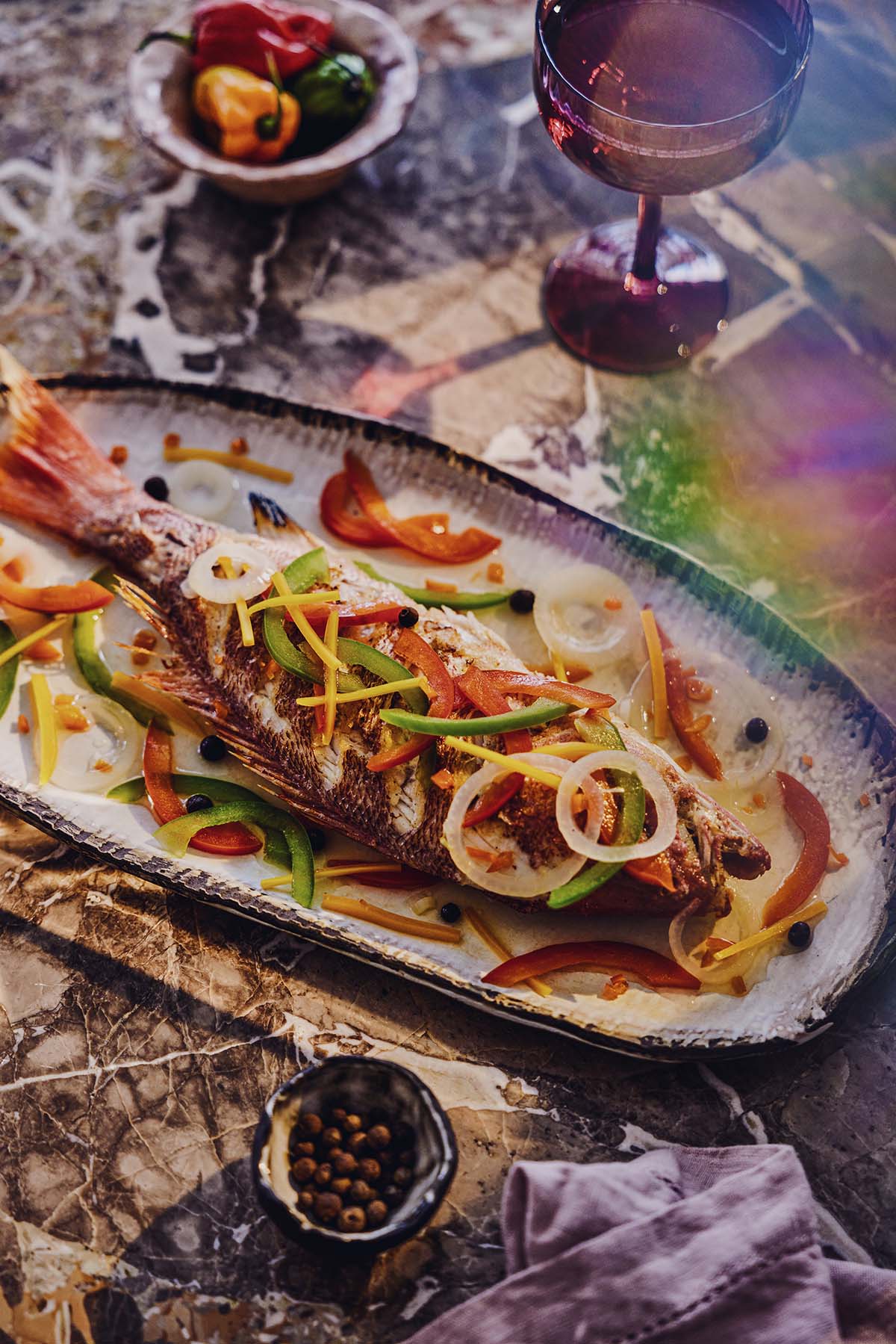
Escovitch Snapper
- 1 whole fresh snapper (about 3 lb), cleaned and scaled
- Salt and pepper, to taste
- Vegetable oil, for cooking
- 2/3 cup vinegar
- 1/2 cup water
- 3 tablespoons vegetable oil (it can be left over from frying fish)
- 1 teaspoon chicken bouillon powder
- 1 carrot, julienned
- 1 small onion, sliced into rings
- 10 pimento berries (allspice), optional
- 1/2 Scotch bonnet pepper, seeded and chopped (wear gloves)
- 1/2 each green and red bell pepper, julienned
Pat the snapper dry with paper towel, season with salt and pepper and lightly score on each side. Heat a generous drizzle of oil in a heavy skillet and cook the snapper for about five minutes each side, until just cooked through; transfer to a paper towel-lined plate.
In a medium saucepan, bring the vinegar, water, oil and bouillon powder to a simmer. Add the carrots and let simmer for about a minute, season with salt and pepper, then add the onion and simmer for about five minutes, or until the onion is transparent. Add the pimento berries, if using, and Scotch bonnet. Add the peppers and cook for another minute. Serve the sauce over the crispy fish.

Jae-Anthony Dougan
OntarioChef Jae-Anthony Dougan went from stylist at Holt Renfrew to caterer working out of his parents’ garage, to entrepreneur showcasing Caribbean cuisine at restaurants, pop-ups and special events, combining regional and imported ingredients to create dishes reflective of a diverse and underrepresented region. The 36-year-old competed on Top Chef Canada this spring, will soon be a judge on Food Network’s Wall of Chefs, and is in the process of opening the second location of his Montreal restaurant, Tropikàl, in Ottawa this year. Toronto, with the largest Caribbean population in Canada, will get the third in 2022.
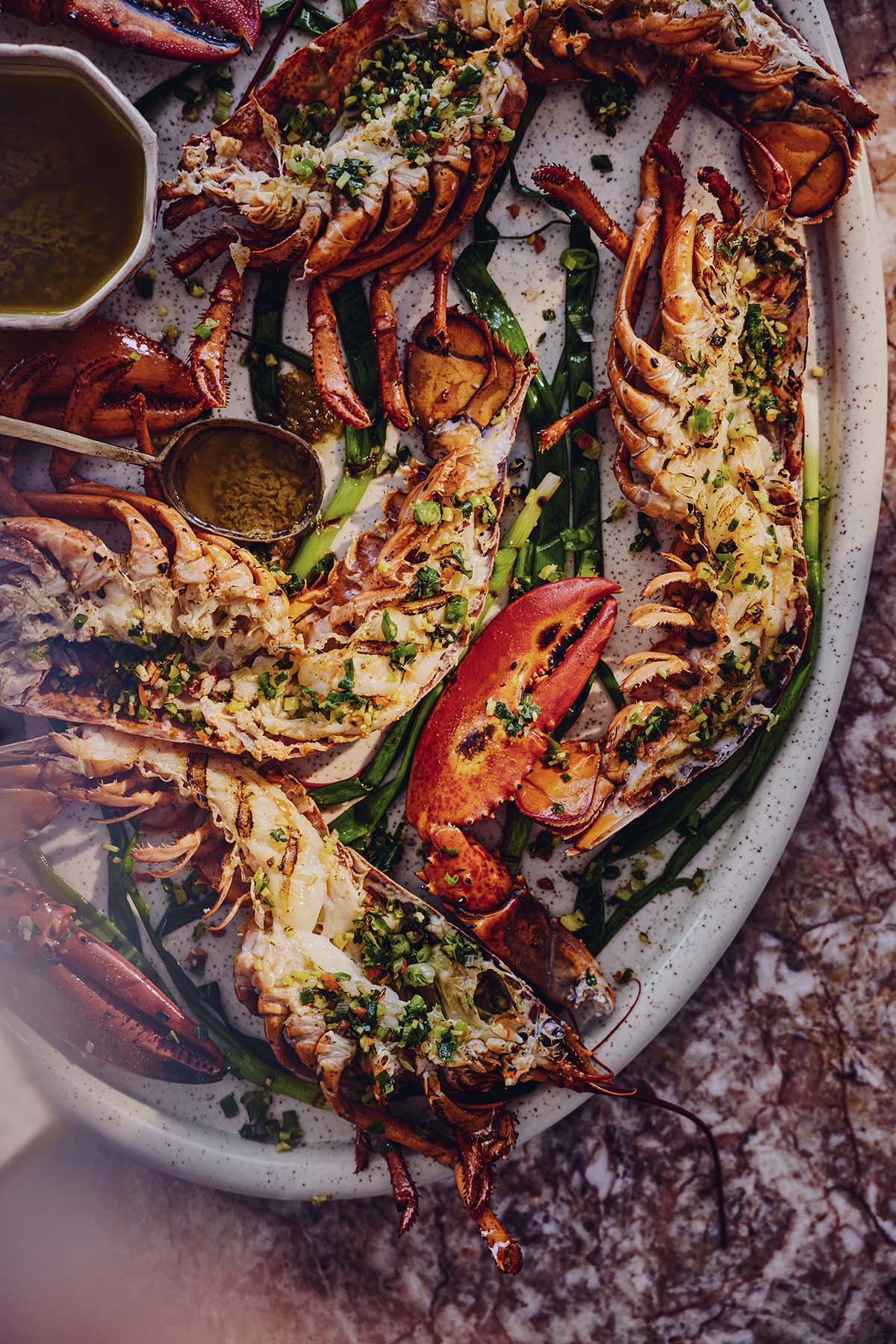
Jerk Lobster
- 4 (1 1/2-pound) live lobsters
- 1 1/2 bunches scallions (about 12 scallions), divided
- 3 tablespoons fresh ginger, peeled and chopped
- 2 tablespoons fresh lime juice
- 1 tablespoon fresh thyme leaves
- 1 garlic clove, chopped
- 1 Scotch bonnet pepper, stemmed, seeded and chopped
- 1 teaspoon kosher salt, divided
- 1/2 cup unsalted butter, cubed
- 3/4 cup Grace jerk marinade
- Canola oil, for cooking
Halve the lobsters lengthwise and clean them; detach and reserve their claws. Chop half the scallions and combine with the ginger, lime juice, thyme, garlic, Scotch bonnet and about 3/4 teaspoon salt. Rub all over the cut side of the lobsters and refrigerate for at least two hours. Melt butter in a small saucepan over medium-low. Whisk in jerk marinade until combined and remove from heat. Reserve 1/4 cup jerk butter in a small bowl for serving.
Preheat grill to medium-high (400 F to 450 F). Toss the canola oil with the remaining whole scallions in a large bowl; season with remaining 1/4 teaspoon salt and pepper. Place scallions on oiled grates and grill, uncovered, turning occasionally, until lightly charred and tender, about five minutes. Set aside.
Grill the lobster cut side down for 2-3 minutes, then flip, brush with jerk butter and grill another 2-3 minutes, until just cooked through. Serve with extra jerk butter.

Fanny Ducharme
QuebecChef Fanny Ducharme grew up in Sainte-Adèle, trained at the École Hôtelière des Laurentides and spent much of her 20s in the kitchens of the Cabane à sucre au Pied-de-Cochon. At 31, she’s now chef and co-owner of L’Épicurieux in Val-David, where her constantly changing menu is strongly influenced by Quebec’s boreal forests. Ducharme brings vegetables to the forefront when they’re in season and at their peak, though there are some thoughtfully sourced proteins among her small plates and larger family-style dishes. This spring, she was profiled as an up-and-coming chef to watch in the new book Today’s Special: 100 Emerging Chefs Around the World.

Roasted Cabbage and Bagna Cauda
- 1 whole cabbage
- Vegetable oil, for cooking
- 1 large head garlic, separated into cloves and peeled
- 1 cup milk
- 8-10 anchovy filets
- Zest and juice of 1 lemon
- 2/3 cup camelina oil
- 1/4 cup camelina seeds
- 1/2 baguette, sliced or torn into chunks
Preheat the oven to 425 F.
Cut the cabbage lengthwise into quarters, leaving the stem end intact. Drizzle some oil into an ovenproof pan and set over medium-high heat. Sear each wedge very well on one side, then transfer to the oven for 20 minutes, or until tender enough to easily insert a knife.
In a saucepan, cook the garlic in the milk for 30 minutes, or until the garlic is tender and golden. Remove from heat and add anchovies. Let rest for 10 minutes before blending everything together until very smooth.
With the blender running, add the lemon juice and then gradually add the camelina oil to emulsify the sauce. (It won’t thicken as much as a mayonnaise, but should be smooth and velvety.)
Turn the oven up to 450 F. Spread the pieces of baguette out on a baking sheet and toast until golden. Reduce the heat to 300 F and cook for 15 minutes longer to dry the bread very well. Let it cool and pulse in a food processor until it’s very fine, the texture of sand. Transfer to a bowl and mix in the camelina seeds and lemon zest.
To assemble, spread the bagna cauda generously on the bottom of the plate. Place the cabbage on the sauce, browned side up, and top with the crumbs.

Alex Mayberry
New BrunswickLike many New Brunswick chefs, 30-year-old Alex Mayberry spends plenty of time outdoors, foraging the wild mushrooms, berries, herbs, fiddleheads, ramps and other edibles the province is known for. With easy ocean access, he even makes his own sea salt. Mayberry’s menu at the Shadow Lawn Inn in Rothesay, where he is the executive chef, changes with the seasons, but even the weather affects what they cook from day to day. Fresh seafood and produce are often caught and harvested mere hours before being delivered to the restaurant, which is located across the street from Kennebecasis River and surrounded by farmland, to be prepared, plated and served.
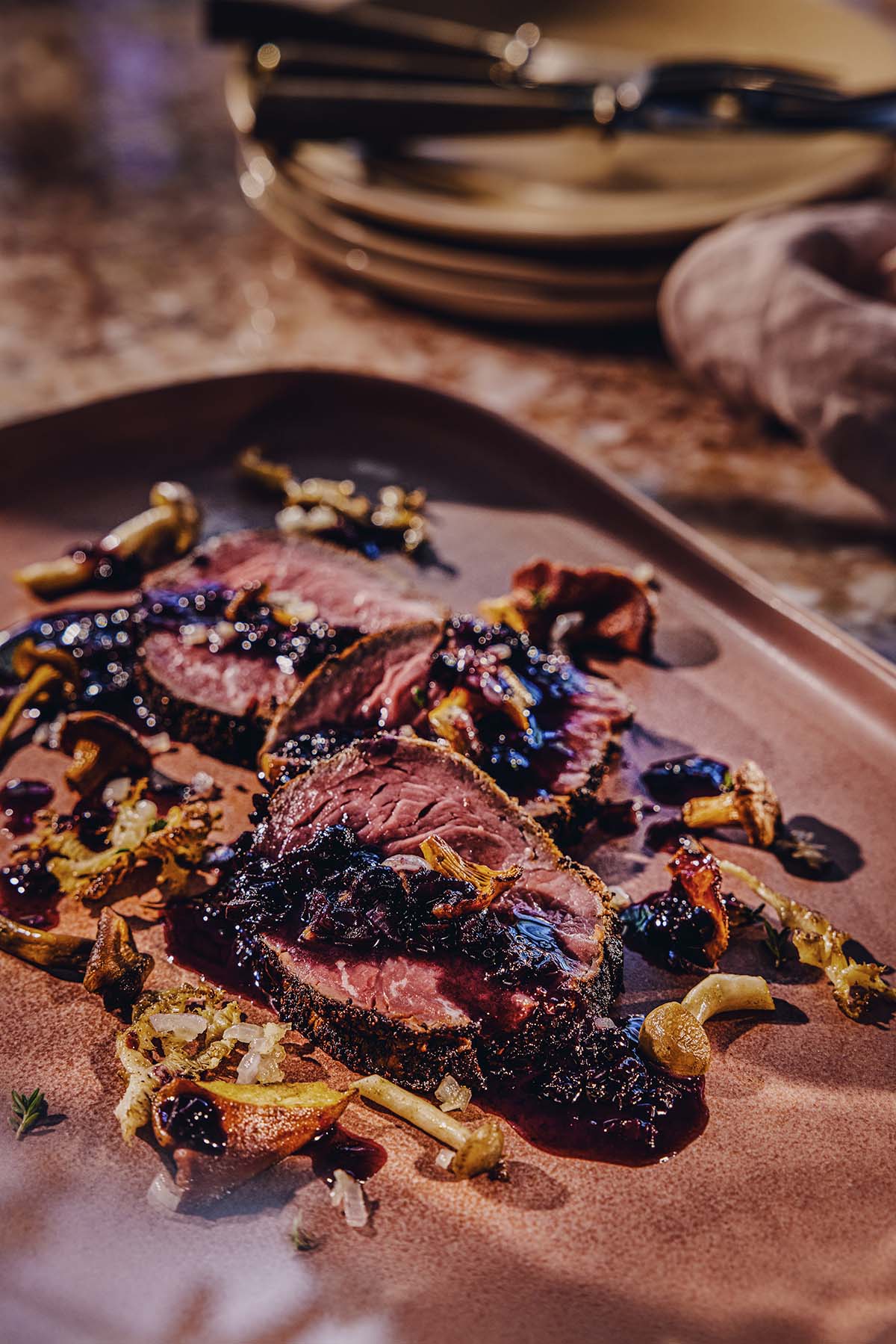
Smoked Cocoa and Espresso Moose Tenderloin with Wild New Brunswick Mushrooms
- 2.5 lbs moose loin (or substitute beef)
- 2 tablespoons roasted espresso beans, ground
- 2 tablespoons raw cocoa, ground
- 2 tablespoons dried Pasilla chilies, ground
- 1 tablespoon Muscovado or dark brown sugar
- 1 tablespoon paprika
- 2 teaspoons freshly ground pepper
- 2 teaspoons sea salt
- 2-3 cups fresh wild New Brunswick mushrooms, roughly chopped
- 1/4-1/2 cup butter, divided
- 2 shallots, finely chopped, divided
- 2 garlic cloves, minced, divided
- A sprig or two of thyme
- 1 cup reserve port wine
- A handful of black currants
Heat a drizzle of oil in a heavy skillet over medium-high heat and sear the moose roast until browned on all sides. Combine the ingredients for the dry rub and spread all over the surface of the meat, and place in a smoker with willow wood at 250 F for 1 hour and 15 minutes, or until the internal temperature reads 115 F. Set aside, loosely covered with foil, to rest.
In the same skillet, sauté the wild mushrooms over medium-high heat with 2-3 tablespoons butter, a chopped shallot and garlic clove and the leaves pulled from a sprig or two of thyme, for 4-5 minutes or until the mushrooms have softened and are starting to caramelize on the edges. Set aside.
To make the port sauce, add a drizzle of oil to the pan and sauté the remaining shallot and garlic until soft. Add about a cup of port wine and reduce until thickened. Add a handful of black currants and a few pats of cold butter and cook just until the berries soften.
To serve, slice the moose loin and top with mushrooms and port sauce.

Kim MacPherson
Nova ScotiaChef Kim MacPherson and her husband, Mark Pehlke, dreamed of one day opening a true farm-to-table dining experience; the pair spent time in kitchens and gardens across the country before settling on a picturesque 40-acre homestead in Musquodoboit Harbour, where they opened Lupin Dining & Pantry. Nurtured by regenerative permaculture practices, their gardens provide a stunning backdrop for special events and inspire MacPherson’s small, constantly changing menu. The 32-year-old sources what they don’t grow themselves from surrounding farms.
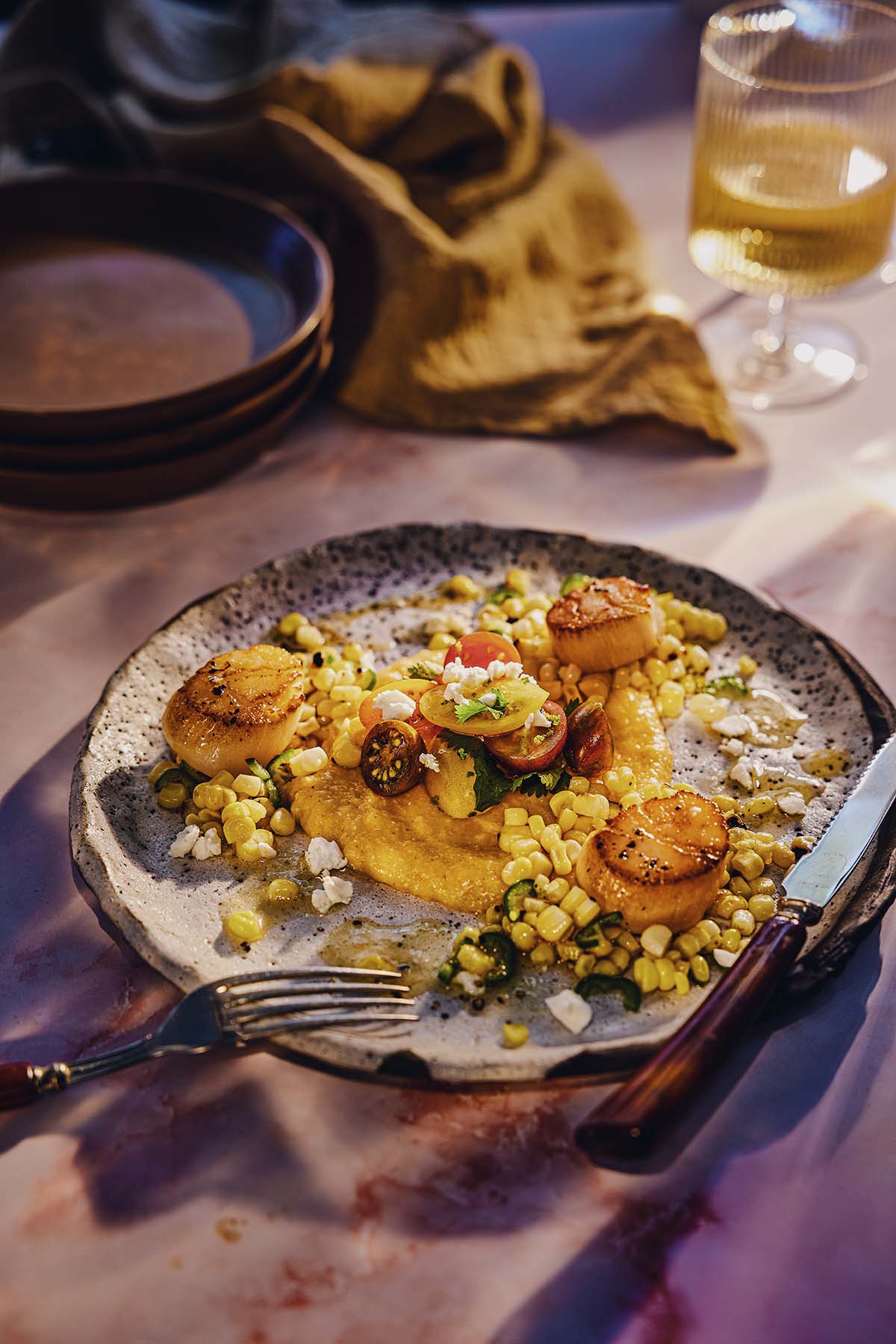
Scallops with Polenta and Chili Grilled Corn
- 1/2 cup fine cornmeal
- 2 cups water
- 1/2 teaspoon Mexican chili powder
- 1/4 teaspoon paprika
- 1/4 teaspoon smoked paprika
- 3 tablespoons heavy cream
- Sea salt, to taste
- 2 tablespoons crumbled goat milk feta
- 6-8 heirloom grape tomatoes, halved and sliced
- 10-12 cilantro leaves
- 1/2 lime, zest and juice
- 1 1/2 teaspoon olive oil
- Sea salt and freshly ground black pepper, to taste
- 2 cobs corn, husked
- 2 tablespoons butter
- 1/2 jalapeno or other green chili pepper, seeded and thinly sliced
- 1 tablespoon vegetable oil
- 6 large scallops seasoned
- 2 tablespoon butter
- 2-3 tablespoons crumbled feta cheese
To make the polenta, bring the water to a boil in a large saucepan and whisk in the cornmeal. Turn the heat down low, add spices and cook until thickened, about eight minutes. Add heavy cream and adjust seasoning; let sit until ready to serve. Adjust thickness with water when reheating.
Toss together the tomato salad ingredients and season with salt and pepper.
Brush husked cobs with oil, season with salt and pepper and grill for about 10 minutes, until tender and charred. Cut the kernels off the cob. In a large skillet, melt the butter over medium-high heat and sauté the corn and chilis, seasoning with salt as needed.
Season scallops with salt and pepper, and heat the oil in a small pan over medium-high heat and sear scallops on one side, until nicely browned. Flip and take the pan off the heat, adding butter to finish cooking the scallops.
To serve, spoon a loose dollop of polenta onto each plate and spread into an even circle in the centre. Spoon corn in three spots on the plate and set scallops on top, seared side up. Pile the tomato herb salad in the middle of the plate and crumble remaining feta cheese around the perimeter.

Hunter Guindon
Prince Edward IslandChef Hunter Guindon was drawn to cooking at a young age, he says, because it stimulated all his senses. Born with cystic fibrosis, he felt he had little control over his life, but felt liberated by the ability to create meals that looked, tasted and smelled just the way he wanted. Now 25, Guindon has been sous chef at Terre Rouge and Fireworks at the Inn at Bay Fortune, and is now at the helm at the Table Culinary Studio in New London, where 90 per cent of their hyper-local menu is sourced from within 15 minutes of the restaurant, fished or farmed by friends.
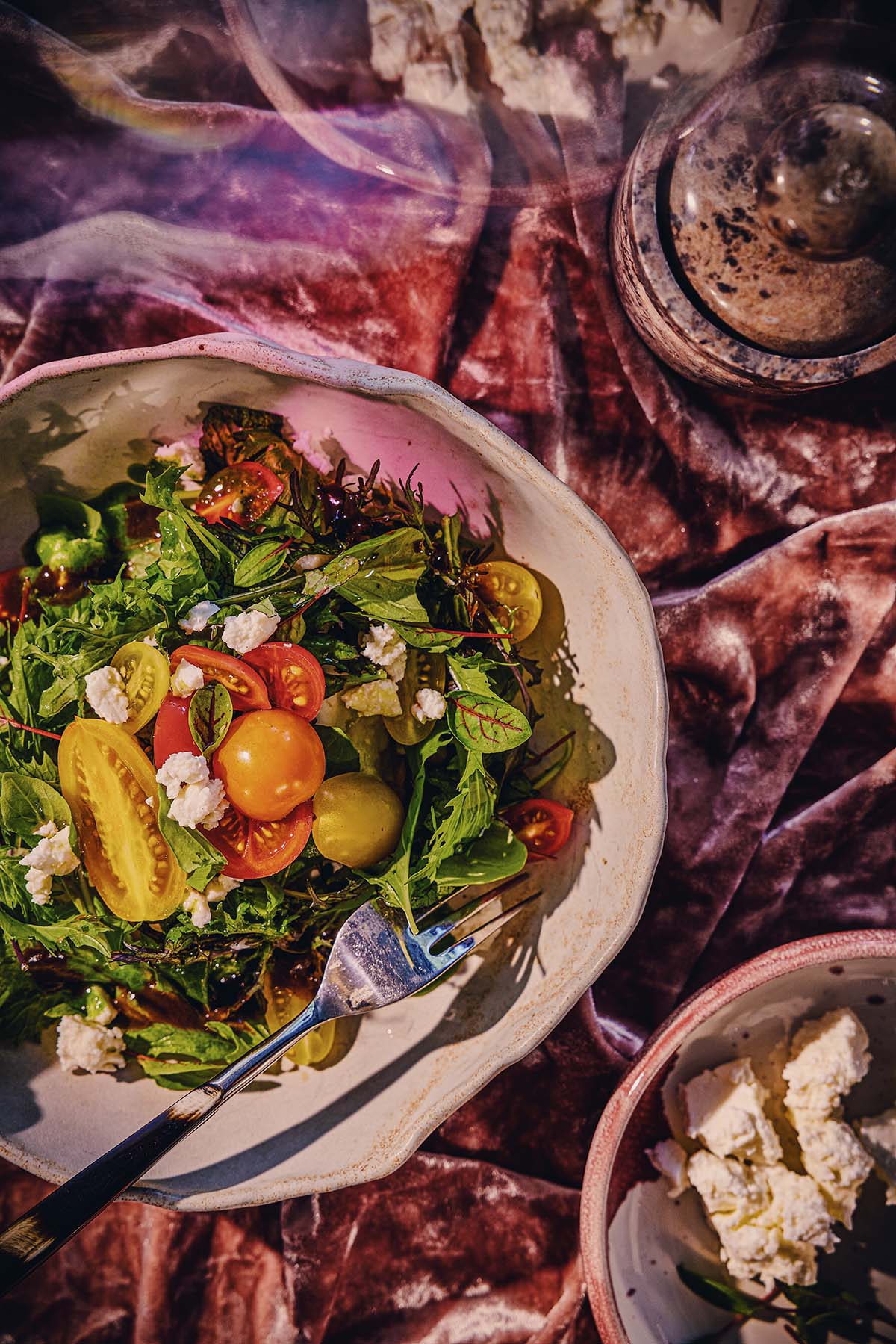
The Table’s Local Tomato Salad
- 1/2 small white onion, thinly sliced
- 3 cloves garlic, thinly sliced
- 4 tablespoons rhubarb juice (or substitute unsweetened cranberry juice or lemon juice)
- 1/2 bunch basil
- 1/2 bunch dill
- 2 cups cold pressed canola oil
- Salt
- 6 heads black garlic, peeled
- 3 cups white wine vinegar
- 2 tablespoons honey
- Equal parts rhubarb juice and cold-pressed canola oil, with a pinch of salt
- 2 cups mixed greens
- 1/2 pint heirloom cherry tomatoes, at their peak
- Good quality pressed ricotta
To make the vinaigrette, macerate the onion and garlic in rhubarb juice for about 20 minutes, then place in a blender with the herbs. With the blender on low, slowly drizzle in the oil until fully incorporated. Season with salt and more rhubarb juice, if needed, to taste.
For the black garlic reduction, combine the black garlic, vinegar and honey in a saucepan and simmer until reduced by half; purée until smooth, strain and season with salt.
To assemble, season the greens with rhubarb vin, and both greens and tomatoes with salt. Place in a bowl and drizzle black garlic reduction and the herb vinaigrette to taste around the salad, and crumble some ricotta overtop. Store the extra vinaigrette and reduction in the fridge for future salads.

Amy Anthony
Newfoundland and LabradorBorn and raised in Newfoundland, chef Amy Anthony, 39, has been involved in opening restaurants across the province, and has spent time cooking at Mallard Cottage and catering for film and TV crews while dreaming of her own space. The Nook and Cannery finally become a reality in St. John’s earlier this year. With a quirky eighties rec room vibe, her menu has a strong sense of place, celebrating the people and culinary traditions of Newfoundland and Labrador, with locally sourced ingredients and house-made preserves you can buy to take home to your own kitchen.

Cod Tacos (“Codcos”)
- 1 kohlrabi, julienned
- 1/2 head purple cabbage, julienned
- 2 cloves garlic, minced
- 10 large nasturtium leaves, julienned
- 1-2 small poblano peppers, julienned
- 1 tablespoon caraway seed, toasted
- 2 tablespoons olive oil
- 1 lime, zested and juiced
- 2 cups white rice flour
- 2 cups cornstarch
- 1 1/2 tablespoons baking soda
- 1 1/2 tablespoons baking powder
- 1 tablespoon garlic powder
- 1 tablespoon thyme
- 1 tablespoon smoked paprika
- 1 tablespoon dried parsley
- 1 teaspoon salt
- 1 teaspoon pepper
- 1 tall boy of your favourite local IPA (such as Port Rexton Brewery IPA)
- 1 fresh cod loin and tail, cut into 2.5-3 inch pieces
- Canola or other vegetable oil, for frying
- 10 good-quality corn tortillas
To make the slaw, toss all the ingredients together in a bowl and let it marinate while you prepare the rest.
In a bowl, combine the rice flour, cornstarch, baking soda and powder, spices, salt and pepper. Remove half and put in a shallow bowl. Whisk the beer into the remaining dry ingredients – you should have a mixture with the texture of heavy cream. (Add a little more beer if you need to achieve the right consistency.)
Heat about two inches of oil in a heavy, shallow pot to about 350 F. Dredge the fish pieces in the dry flour mix, then in the wet batter. Repeat one more time and fry until golden. Transfer to a paper towel-lined plate to drain.
Serve the fried fish on fresh tortillas, topped with slaw.

Trudy Metcalfe-Coe
NunavutOriginally from Nain, Nunatsiavut and now based in Ottawa, Inuk chef Trudy Metcalfe-Coe spent 14 years managing the Larga Baffin home for Nunavut Inuit and for more than two decades has been catering, teaching and cooking for special events on the side, preparing traditional ingredients such as musk ox, seal, caribou and arctic char. The 56-year-old chooses projects with a focus on community building and education around Inuit culture. Though the pandemic cut short a stint at Iqaluit’s Qajuqturvik Community Food Centre, when it’s safe she travels to Nunavut often, and teaches basic cooking skills virtually, introducing communities to ingredients and techniques they may be unfamiliar with.

Blackened Arctic Char with Crispy Potatoes and Hollandaise
- 2 medium potatoes, peeled and cut into 1 to 1 1/2-inch pieces
- 2-3 tablespoons butter and/or vegetable oil
- 1 tablespoon chopped garlic
- 1 tablespoon fresh thyme leaves
- 1 tablespoon chopped cilantro
- Smoked paprika, salt and pepper to taste
- 2 teaspoons smoked paprika
- 1 teaspoon each garlic and onion powder
- 1 teaspoon savory
- 1/2 teaspoon thyme
- 1/4 teaspoon each salt, freshly ground black pepper and cayenne (or to taste)
- 1 cup butter (divided)
- 1/4 cup vegetable oil
- 2 four to six-ounce arctic char filets
- 2 egg yolks
- 1/4 cup butter, melted
- Juice of half a lemon
- Chopped fresh dill, to taste
Par boil or cook the potatoes in the microwave for about 6-7 minutes, until tender. Drain and pat dry. Heat butter and/or oil in a large skillet and cook potatoes over medium-high heat, tossing until golden. Add garlic, thyme, cilantro, smoked paprika, salt and pepper. Toss to combine and remove from heat.
Make the hollandaise: Bring a pot with an inch or two of water to a gentle boil. In a metal bowl that will fit on top of the pot, whisk the egg yolks. Place on top of the pot of simmering water and whisk in the melted butter in a steady stream, whisking until thickened. Remove the bowl from the heat and whisk in the lemon juice, smoked paprika, salt and pepper. Stir in a bit of fresh dill. Keep whisking until the bowl is cooler to the touch; place it on a cold wet cloth or in another bowl with ice water to cool it down if you like.
Melt 1/2 cup butter in a dish large enough to dip the fish in. Combine the paprika, garlic and onion powder, savory, thyme, salt, pepper and cayenne in another dish. Dip fillets in butter, and then the blackening seasoning to coat.
Melt the remaining butter with oil in a heavy or cast-iron skillet over medium-high heat. Add the fish (if it has skin, skin side down), and cook for 4-6 minutes on each side for medium. Plate the fish and potatoes, and drizzle with or serve hollandaise on the side for dipping. Garnish with fresh dill, if you like.

Ariel Adams
YukonLike so many residents of Dawson City, chef Ariel Adams came to Yukon for a summer of adventure and never left. Last fall, the 33-year-old helped open Bonton & Company, which began as a backyard butcher shop and has expanded to include a restaurant and café. With a menu that changes every week, Adams’s focus is on creating dishes that revolve around their unique climate, highlighting regional produce and locally raised meats they butcher in-house and turn into sausages, salami and charcuterie.

Cuttlefish Ink Gnocchi, ‘Nduja Marinara, Parmesan cream
- 1 lb Yukon Gold potatoes
- 1 cup all-purpose flour
- 1/4 teaspoon salt
- 1 large egg
- 1 tablespoon cuttlefish ink
- 4-6 ounces Parmesan rinds
- 3 cups heavy cream
- Salt and freshly ground pepper
- 2 shallots, sliced thin
- 3 cloves garlic, sliced thin
- 2 tablespoons olive oil
- 1 28 oz can whole tomatoes
- 1/4 pound ‘nduja (soft fermented pork sausage)
- 1 tablespoon butter
- Optional garnishes: crispy lonza or bacon and fresh basil
Bring a large pot of salted water to boil and cook whole potatoes, skin on, until tender. While they cool, combine Parmesan rinds and cream in a saucepan and simmer for 40 minutes, until thickened. Season with salt and pepper to taste.
Once potatoes are cool, rub off the peel and pass through a potato ricer. Set aside.
In a small bowl, whisk the flour and salt. In another bowl, whisk together the egg and ink. Put the flour mixture on the countertop and make a well in the middle; add potato and mix in the egg mixture. Knead everything together to form a slightly sticky, soft dough, adding flour if needed.
Working with small amounts of dough at a time, roll into a long ropes and cut 3/4-inch pieces. Set aside to rest.
For marinara: Sweat shallots and garlic in olive oil until soft, but not brown. Add tomatoes and crush slightly to release juices. Season with salt. Purée the sauce with an immersion blender. Add the ‘nduja and press to break up in sauce, simmer for 30-40 minutes. Finish with butter.
Bring a large pot of salted water to a boil and cook the gnocchi for 1-2 minutes, or until floating. Transfer to pan with hot butter or olive oil to crisp up, and serve with both sauces drizzled on top.

Niki Mckenzie
Northwest TerritoriesFor Niki Mckenzie, what began as an effort to make a wider variety of lesser-known Northern fish species more palatable evolved into a seasonal outdoor eatery, The Garden, and a fine-casual restaurant called Fin Dining, opening this fall in Yellowknife. Originally from New Zealand, the 34-year-old chef is inspired by the unique terroir of the Northwest Territories, and forages as much as she can, grinding toasted juniper in place of pepper and replacing sugar with birch syrup. Beyond the usual filets, Mckenzie utilizes offal, offcuts, skin and scales, preserving, pickling, curing and smoking every last bit in an effort toward food security and sustainability in the North.

Fish Wings with Fermented Berry Hot Sauce
- 1 1/2 cups Saskatoon berries
- 1 cup low bush cranberries
- About 25 habanero chili peppers, stemmed (you can used dried, just count them out)
- 2 tablespoons kosher salt
- 1/4 cup apple cider vinegar
- 1 tablespoon sugar
- 3-4 lbs fish wings, collars and bellies, with belly fin attached
- 1/4 cup kosher salt
- 1/4 cup sugar
- 1/4 cup loose leaf Labrador tea
- 1 tablespoon whole fennel seed, toasted
- 2 teaspoons whole black peppercorns, toasted
- 2 cups all-purpose flour
- 4 tablespoons paprika
- 1 tablespoon salt
- 1 teaspoon pepper
- 4 cups Panko crumbs
- 6 eggs
- Canola or other vegetable oil, for frying
In a food processor, pulse berries, habaneros and salt until a wet mash forms. Transfer into a sterile mason jar and cover with plastic wrap on the surface of the mash. Seal jar and store in a cool dry spot (i.e., back of the pantry) to ferment for 7 to 10 days. The mash will start to bubble and climb the sides of the jar. Taste for desired sourness. Transfer mash to a blender, add vinegar and sugar and blend on high till smooth and emulsified, adding more vinegar or sugar to taste. Pour through a sieve into a pot and boil for three minutes, stirring so it doesn’t scorch. Transfer into sterile mason jars, seal while hot and cool upside down.
Prep the fish wings: Keep the fins on, scale and remove any small pin bones or ribs. Separate belly fins into two, and separate collars into fin and neck. Rinse well.
Combine the salt, sugar, Labrador tea, fennel seed and peppercorns and cover the fish pieces, using a quantity of cure that’s about 5 per cent of the weight of your fish. Let sit two hours, or overnight. Rinse well and pat dry.
In a shallow bowl, combine the flour, paprika, salt and pepper. Whisk the eggs and weigh them; add an equal quantity (by weight) of water. Put the panko in a third shallow bowl. Heat a couple inches of oil to 325 F in a heavy, shallow pot set over medium-high heat.
Holding the fish pieces by the fin, dip them one at a time in the flour mixture, then egg, then panko. Deep fry a few pieces at a time for about three minutes, or until they float and hit an internal temp of 145 F. Transfer to paper towels to drain and toss with the fermented berry hot sauce to serve.

Editor: Maryam Siddiqi. Art director: Benjamin MacDonald. Interactive editor: Christopher Manza.
Food Styling by Michael Elliott for Judy Inc.
Prop styling by Suzanne Campos for P1M.ca.
Chef headshots courtesy of Mathieu Savidant (Alex Mayberry), Food Network Canada (Christine Pattison), Patrick Adams (Ariel Adams), Noella Steinhauer (Scott Iserhoff), Sara Megan (Fanny Ducharme), Christine Williams (Andrew Han).
Plan your weekend with our Good Taste newsletter, offering wine advice and reviews, recipes, restaurant news and more. Sign up today.



